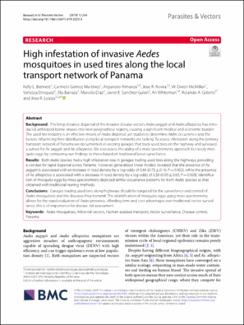| dc.contributor.author | Bennett, Kelly L. | |
| dc.contributor.author | Martínez, Carmelo Gómez | |
| dc.contributor.author | Almanza, Alejandro | |
| dc.contributor.author | Rovira, Jose R. | |
| dc.contributor.author | McMillan, W. Owen | |
| dc.contributor.author | Enriquez, Vanessa | |
| dc.contributor.author | Barraza, Elia | |
| dc.contributor.author | Diaz, Marcela | |
| dc.contributor.author | Sanchez‑Galan, Javier E. | |
| dc.contributor.author | Whiteman, Ari | |
| dc.contributor.author | Gittens, Rolando A. | |
| dc.contributor.author | Loaiza, Jose R. | |
| dc.date.accessioned | 2020-06-28T04:27:14Z | |
| dc.date.available | 2020-06-28T04:27:14Z | |
| dc.date.issued | 2019-05-27 | |
| dc.identifier.other | https://doi.org/10.1186/s13071-019-3522-8 | |
| dc.identifier.uri | http://repositorio-indicasat.org.pa/handle/123456789/137 | |
| dc.description | Background: The long‑distance dispersal of the invasive disease vectors Aedes aegypti and Aedes albopictus has intro‑ duced arthropod‑borne viruses into new geographical regions, causing a significant medical and economic burden. The used‑tire industry is an effective means of Aedes dispersal, yet studies to determine Aedes occurrence and the factors influencing their distribution along local transport networks are lacking. To assess infestation along the primary transport network of Panama we documented all existing garages that trade used tires on the highway and surveyed a subset for Ae. aegypti and Ae. albopictus. We also assess the ability of a mass spectrometry approach to classify mos‑ quito eggs by comparing our findings to those based on traditional larval surveillance.
Results: Both Aedes species had a high infestation rate in garages trading used tires along the highways, providing a conduit for rapid dispersal across Panama. However, generalized linear models revealed that the presence of Ae. aegypti is associated with an increase in road density by a log‑odds of 0.44 (0.73 ± 0.16; P = 0.002), while the presence of Ae. albopictus is associated with a decrease in road density by a log‑odds of 0.36 (0.09 ± 0.63; P = 0.008). Identifica‑ tion of mosquito eggs by mass spectrometry depicted similar occurrence patterns for both Aedes species as that obtained with traditional rearing methods.
Conclusions: Garages trading used tires along highways should be targeted for the surveillance and control of Aedes‑mosquitoes and the diseases they transmit. The identification of mosquito eggs using mass spectrometry allows for the rapid evaluation of Aedes presence, affording time and cost advantages over traditional vector surveil‑ lance; this is of importance for disease risk assessment. | en_US |
| dc.description.abstract | Background: The long‑distance dispersal of the invasive disease vectors Aedes aegypti and Aedes albopictus has intro‑ duced arthropod‑borne viruses into new geographical regions, causing a significant medical and economic burden. The used‑tire industry is an effective means of Aedes dispersal, yet studies to determine Aedes occurrence and the factors influencing their distribution along local transport networks are lacking. To assess infestation along the primary transport network of Panama we documented all existing garages that trade used tires on the highway and surveyed a subset for Ae. aegypti and Ae. albopictus. We also assess the ability of a mass spectrometry approach to classify mos‑ quito eggs by comparing our findings to those based on traditional larval surveillance.
Results: Both Aedes species had a high infestation rate in garages trading used tires along the highways, providing a conduit for rapid dispersal across Panama. However, generalized linear models revealed that the presence of Ae. aegypti is associated with an increase in road density by a log‑odds of 0.44 (0.73 ± 0.16; P = 0.002), while the presence of Ae. albopictus is associated with a decrease in road density by a log‑odds of 0.36 (0.09 ± 0.63; P = 0.008). Identifica‑ tion of mosquito eggs by mass spectrometry depicted similar occurrence patterns for both Aedes species as that obtained with traditional rearing methods.
Conclusions: Garages trading used tires along highways should be targeted for the surveillance and control of Aedes‑mosquitoes and the diseases they transmit. The identification of mosquito eggs using mass spectrometry allows for the rapid evaluation of Aedes presence, affording time and cost advantages over traditional vector surveil‑ lance; this is of importance for disease risk assessment. | en_US |
| dc.language.iso | eng | en_US |
| dc.rights | http://creativecommons.org/licenses/by/4.0/ | |
| dc.rights | info:eu-repo/semantics/openAccess | |
| dc.subject | Aedes mosquitoes | en_US |
| dc.subject | Arboviral vectors | en_US |
| dc.subject | Human-assisted transport | en_US |
| dc.subject | Vector surveillance | en_US |
| dc.subject | Disease control | en_US |
| dc.subject | Panama | en_US |
| dc.title | High infestation of invasive Aedes mosquitoes in used tires along the local transport network of Panama | en_US |
| dc.type | info:eu-repo/semantics/article | en_US |
| dc.type | info:eu-repo/semantics/publishedVersion | |

